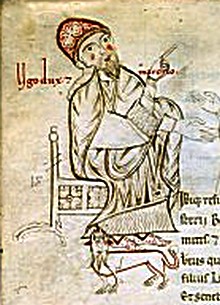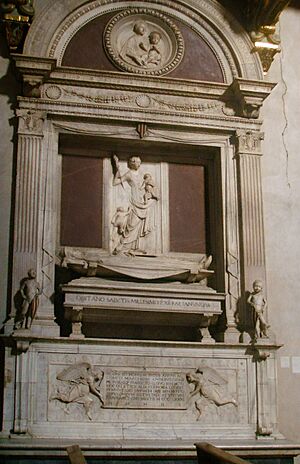Hugh, Margrave of Tuscany facts for kids
Hugh (Latin: Ugo, Hugo; born 953 or 954 – died December 21, 1001), also known as Hugh the Great, was an important ruler in Italy. He was the Margrave of Tuscany from 969 until his death in 1001. He also held the titles of Duke of Spoleto and Margrave of Camerino from 989 to 996.
Hugh was famous for making the government in Tuscany strong again. Before him, many rulers had not paid much attention to it. He was also a big supporter of the new Ottonian dynasty, which was the ruling family in Italy at the time. A writer from his era, Peter Damian, even praised Hugh for being a very fair and just leader. Hugh worked closely with the Papal States (the lands ruled by the Pope) to solve land disagreements. He was also very generous, giving public lands to help build monasteries for the Catholic Church.
Hugh's Early Life and Role
Hugh was the son of Hubert, who was the son of King Hugh. His mother was Willa. She was the daughter of Boniface I, who was the Duke of Spoleto.
When Hugh became Margrave, Tuscany was not yet full of castles everywhere. The king did not often get involved in local matters. Hugh's territory was larger than it had been under previous rulers. His power came from the rich cities in the Arno valley, and he also owned a lot of land.
As Margrave, Hugh had his own courts, places to make coins, and an army. The land he gave to churches and monasteries was mostly public land. Towards the end of his life, he gave away more and more public land to help set up new monasteries. This increase in gifts to monasteries by Hugh and his loyal followers is seen as a sign of a "spiritual revival" during his time.
Hugh supported the Guidi clan, a powerful family, by giving them lands near Arezzo. He also gave land to churches in the city. These gifts were later confirmed by the emperors Otto III and Henry II. Hugh also helped Emperor Otto III with his church reforms and in conflicts against Venice.
Solving Land Disputes
In 996, Emperor Otto III put eight counties near the Adriatic Sea under the shared control of Hugh and another ruler named Conrad of Ivrea. These counties were disputed between the Emperor and the Pope. Otto also left an official to oversee the courts and money in these areas.
Emperor Otto III wrote a letter to Pope Gregory V in 996. He said that Hugh of Tuscany was "faithful to us in everything" and would help the Pope. This shows how much the Emperor trusted Hugh.
Hugh was also interested in the monastery of Bobbio, which was having problems. He exchanged letters with its abbot, Gerbert of Aurillac, who later became Pope Sylvester II. Hugh and Conrad of Ivrea even asked the Empress Theophanu to come to Italy to help fix things at Bobbio. When Gerbert became Pope, Hugh was present at a meeting in Rome in 1001.
In 992, a revolt broke out in Principality of Capua after its ruler was killed. Hugh, whose job was to keep the southern Italian lands connected to the empire, stepped in. He helped place the youngest son of the previous ruler, Laidulf, on the throne and stopped the revolt.
Death and Lasting Memory
Hugh died in Pistoia in 1001. After his death, the strong government he had built in Tuscany weakened. For example, a war broke out between the cities of Lucca and Pisa in 1004. Hugh did not have any children with his wife, Judith.
He was buried in the Badia Fiorentina, a church his mother had founded in 978. A beautiful monument to him was later added there by the artist Mino da Fiesole.
The monks at Badia Fiorentina still remember Hugh every year on December 21st, which is the feast day of Saint Thomas. Over time, many stories and legends grew around Hugh's life. A writer in the 1600s, Placido Puccinelli, remembered him as a good and religious prince. People even said that his tomb was a place where special visions could be seen.
The famous Italian poet Dante Alighieri mentioned Hugh in his great work, Paradiso. Dante called Hugh a "great baron," showing how important and respected he was.



